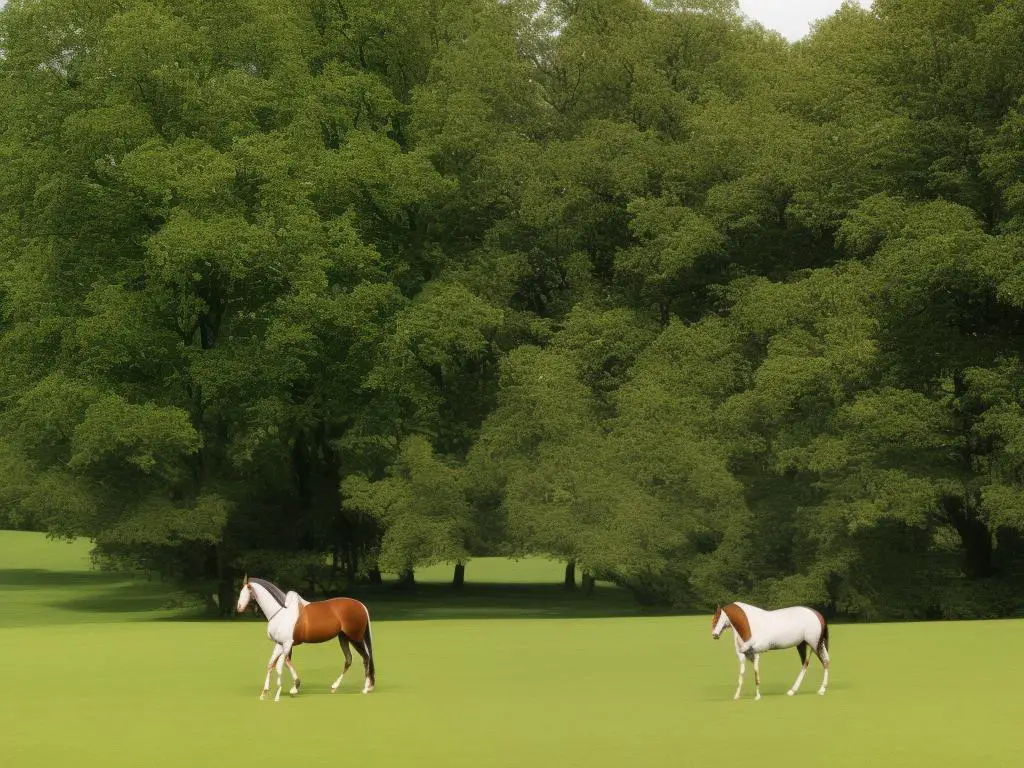The German Warmblood registry, with its long-standing history, distinct breed standards, and systematic registration process, plays a pivotal role in breeding, selling, and competition of warmblood horses on a global scale. This world-renowned registry not only ensures the maintenance of quality and standards in the horse-breeding industry but also significantly impacts the value of these magnificent animals. Our exploration will journey through the intriguing chronicles of the registry’s inception and evolution, delve into a thorough dissecting of the unique traits and performance of the different registered breeds, simplify the registration process, and shed light on the far-reaching implications of the German Warmblood Registry in the sphere of equestrian sports and beyond.
Table of Contents (Horspedia)
History of the German Warmblood Registry
The German Warmblood Registry
The German Warmblood Registry, known in Germany as the Deutsches Reitpferd, was established to provide standards and guidelines for the breeding, raising, and training of German warmblood horses. While there are several types of horses included under the umbrella of German warmbloods, the focus of the registry has primarily been on creating a superior sport horse, capable of excelling in dressage, show jumping, and eventing.
The Formation of the German Warmblood Registry
The formation of the German Warmblood Registry dates back to the late 19th and early 20th century. It was a time when the demand for heavy draft horses was declining and a new market was arising for athletic, agile horses capable of performing in various equestrian sports. Recognizing this shift in demand, several regional breeding associations in Germany came together to form the Zentralverband Deutscher Pferdezüchter, the Central Association of German Horse Breeders, which later became the German Warmblood Registry.
Key Events in the History of the German Warmblood Registry
One key event in the history of the German Warmblood Registry was the disastrous effect of the two World Wars which hindered the development and progress of the registry. However, in the post-war period, the registry underwent a transformation and recovery period aiming to create a uniform breed standard for each of the different types of warmbloods.
In the 1980s and 1990s, the focus of the registry shifted to adapt to the increasing international demand for high-quality dressage and show jumping horses. During this period, the use of performance tests for stallions and mares was introduced as a key element of the selection process, ensuring that only the best animals were included in the registry.
Changes in Guidelines and Definitions
Through the years, the guidelines and definitions used by the German Warmblood Registry have adapted to reflect the evolution of the warmblood breeds. For instance, the registry now recognizes several breeds as distinct types of German warmbloods, such as the Hanoverian, Oldenburg, and Holsteiner.
In addition, the criteria used to evaluate horses for inclusion in the registry have shifted from physical characteristics alone to also include performance measures, particularly in dressage, show jumping, and eventing. This shift reflects the changing demands of the market and the desire to breed horses that are not only aesthetically pleasing but also athletically capable.
The German Warmblood Registry Today
Today, the German Warmblood Registry is one of the most respected and influential horse breeding organizations in the world. Many extraordinary sport horses listed in international rankings are German warmbloods, demonstrating the success of the registry’s breeding programs.
Standards for inclusion in the registry remain high, ensuring that German warmbloods continue to be known worldwide for their athleticism, grace, and power. As the repository of more than a century’s worth of breeding records and data, the German Warmblood Registry continues to contribute significantly to the advancement of horse breeding.
Summary
The German Warmblood Registry represents the fruit of many generations of meticulous selection and breeding, and it stands not as a mere relic of the past but a living and dynamic organization. Its influence extends deeply into the world of horse breeding, not just in Germany, but throughout the global community as well. Born from a fluctuating horse market and now internationally recognized, the German Warmblood Registry occupies a vital and commanding position within the sphere of equestrian sports.

Breeds in the German Warmblood Registry
Exploring the German Warmblood Registry
The ‘Deutsches Reitpferd’, prevalently referred to as the German Warmblood registry, encompasses a variety of horse breeds specifically bred for sporting events like dressage and show jumping. Breeds like the Hanoverian, Holsteiner, Oldenburg, and Westphalian, to name but a few, fall under this registry. The registry meticulously maintains specific standards unique to each breed.
Hanoverian Breed
The Hanoverian breed is one of the most popular and renowned in the German Warmblood registry. Famous for their elegance, temperament and athleticism, these horses are incredibly versatile, and have earned a reputation for their impressive performance abilities particularly in dressage, showjumping and eventing. They are known for their agile movements, predictable temperament and eagerness to work. Hanoverians are typically strong and muscular, with a harmonious physique. The German Hanoverian Society sets strict selection criteria for this breed, ensuring that the horses are able to maintain the expected high performance and quality.
Holsteiner Breed
Holsteiners are one of Germany’s oldest warmblood breeds, and the registry has a strict focus on maintaining the quality of these horses. The breed is known for its incredible jumping ability, power and compact structure. Often used for competitive jumping and dressage, Holsteiners have a sturdy build, strong hindquarters, and are typically a calm and docile breed. The registry emphasizes the strong athletic abilities of this breed, making the Holsteiner an excellent horse for competitive riding.
Oldenburg Breed
The Oldenburg breed is considered one of the most refined in the German Warmblood registry. Often noted for their elegant movements and striking appearances, Oldenburg horses are known for their well-balanced and muscular bodies. These warmbloods have a strong, energetic gait and are incredibly adaptive, making them a popular breed in both dressage and jumping. The Oldenburg Horse Breeder’s Society ensures strict and rigorous breeding standards for this breed to uphold its outstanding quality and distinct characteristics.
Westphalian Breed
A Westphalian horse is undoubtedly athletic and designed for performance, making them a noteworthy inclusion in the German Warmblood registry. Originally bred for work, Westphalians have evolved into versatile athletes suited for dressage, jumping, and driving. They have a beautifully balanced conformation, with a strong and muscular stature. The studbook for the Westphalian horse is maintained by the Westphalian Horse Studbook e.V in Germany, ensuring that the standards for this breed remain high and consistent.
Conclusion
The German Warmblood Registry is an exceptional catalog of equine breeds that have been selectively bred for not just their performance and versatility, but also their temperament. The demanding criteria applied for registration, which differs from one breed to another, ensures that only the finest horses are accepted. The registry is proud to include breeds such as the Hanoverian, Holsteiner, Oldenburg, and the Westphalian, each celebrated for their unique traits and exceptional performance in a range of equestrian sports.

Registration Process on the German Warmblood Registry
##The German Warmblood Registry##
Renowned for its selectivity and rigorous standards, the German Warmblood Registry stands as one of the oldest and most prestigious horse registries worldwide. It takes pride in maintaining the integrity and quality of horse breeds through its meticulous registration process. This process includes stringent checks for eligibility, exhaustive paperwork, and comprehensive vetting to ensure that only the highest tier of equine conform to its standards.
##Eligibility##
The first step in registering your horse with the German Warmblood Registry is to verify your horse’s eligibility. A horse of any breed can be registered as long as it meets the eligibility requirements that primarily focus on breed-specific traits. The horse must be a Warmblood, a mixed-breed that includes any combination of Thoroughbred, Arabian, and ‘warmblood’ breeds such as Hanoverian, Holsteiner, Oldenburg, and Trakehner. To authenticate the breed, the registry typically requires DNA verification to match the horse to its sire and dam. The horse must also meet the age limit for registration, which generally is under the age of two.
##Paperwork Required##
After confirming the horse’s eligibility, the owner must complete the necessary paperwork. This includes an application form that details the horse’s pedigree, a DNA sample for parentage verification, and the appropriate registration fees. The application form must be filled out completely and signed by the owner. It should include comprehensive information like the horse’s name, sex, color, breed, and date of birth, along with the sire and dam’s names and registration numbers.
##Vetting Processes##
The vetting process is one of the most significant components of the German Warmblood Registry registration process. It ensures that only the healthiest and best quality horses get registered. A veterinarian must conduct a complete assessment of the horse, including checking the horse’s conformation and measuring its proportions. The vet also needs to evaluate the horse’s movement and overall health. All these details must be recorded and included in the application.
Also, the registry organizes inspection or classification events where horses are evaluated in hand and under saddle. Horses are judged based on their type, correctness, and movements. These inspections are critical in maintaining breed purity and functional traits typical to warmbloods.
##Conclusion##
The German Warmblood Registry’s primary objective is to preserve the quality and purity of the German Warmblood breed. This is achieved through a stringent registration process that assesses each horse’s eligibility, involving a tireless review of paperwork and thorough vetting procedures. Even though these procedures may seem demanding, they are integral to maintaining the high caliber for which these horse breeds are renowned. By ensuring the authenticity of each horse, the German Warmblood Registry provides an added layer of trust for prospective buyers, making it a fundamental part of the equestrian industry.

Impact and Significance of the German Warmblood Registry
Understanding the German Warmblood Registry
German warmblood horses have gained global recognition for their athletic abilities, versatility, and agreeable temperament. The German Warmblood Registry significantly contributes to preserving these distinct traits by setting stringent quality standards for the breed. It exerts a significant influence on breeding protocols, sales, and competition parameters within the realm of horse sports. Its rigorous quality benchmarks have set the bar high in equestrian disciplines all around the world, thus extending its impact far beyond the borders of Germany.
Relevance to Breeding and Quality Standards
One of the foremost impacts of the German Warmblood Registry, is its role in setting stringent breeding and quality standards. German warmbloods are not a breed in the traditional sense. Instead, they are a group of several breeds with similar characteristics, selectively bred to meet specific criteria. The registry ensures that only horses that pass rigorous inspections and performance tests are approved for breeding. These inspections evaluate the horse’s conformation, gait, and jumping ability, among other characteristics. This meticulous evaluation process directly contributes to the high standard of athleticism and performance seen in German warmbloods. By imposing these conditions, the registry maintains the high quality and credibility of these horses.
Influence on Sales and Market Prices
The German Warmblood Registry also has an enormous impact on the equine market. Its reputation for upholding strict breeding standards significantly influences the prices of German warmblood horses. Typically, the more closely a horse conforms to the registry’s standards, the higher its market value. Buyers often perceive horses approved by the registry as safer investments due to their presumed genetic superiority and potential for success in different horse sport disciplines. It’s also important to note that the registry hosts auctions that present a platform for breeders to showcase their finest stock, further fueling the competitive market prices.
Recognition in Horse Sport Disciplines
The impact of the German Warmblood Registry isn’t limited to breeding practices and market values. It’s considerably influential in the global recognition of German warmbloods in horse sport disciplines. The registry directs breeding towards producing horses ideal for equestrian sports such as dressage, show jumping, and eventing. As a result, German warmbloods commonly dominate these disciplines at the international level, with the registry playing an instrumental role in maintaining this dominance. The high performance and success ensured by the registry’s stringent standards further solidify the global recognition of these horses.
Continuing Importance of the German Warmblood Registry
The role and importance of the German Warmblood Registry extends beyond breeding parameters and horse disciplines. Their research programs dedicated to equine health, genetic diseases, and continuous improvement of breeding methods underscore their commitment to the welfare and development of the German warmblood. In this way, the registry’s impact ranges from maintaining the breed’s exceptional quality, to influencing their market value and global sports recognition. In a broader perspective, the German Warmblood Registry exemplifies how breed registries can protect, improve, and maintain standards for different animal species.

Undeniably, the German Warmblood Registry holds an influential position within the horse-breeding industry and global equestrian sports culture. Reflecting on its rich history and the intricate breed details offers an enhanced understanding of its status and value. The in-depth examination of the registration process unveils its consistency and credibility, while acknowledging its impact underscores its intrinsic role in shaping horse sport norms, price determinants, and quality standards. The journey through this exploration fosters an informed perspective on the German Warmblood Registry, its methodology, and how it has contributed to defining the world of warmblood horses.
